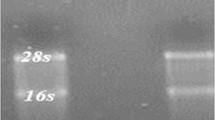Abstract
Despite of promising improvements in treatment of gastric cancer, the mortality rate of this malignancy remains high. Chronic infection by Helicobacter pylori, interfering with intracellular signalling pathways, is the main risk factor for gastric cancer. Some evidence suggests that microRNAs (miRNA), the small noncoding RNA molecules, can play role as oncogenes or tumour suppressors in the cells. MiR-222 is one of the remarkable miRNAs undergoing upregulation in gastric cancer. However, the association between miR-222 upregulation and H. pylori infection in gastric cancer tissues remains unclear. The aim of this study was to analyse the expression level of miR-222 in gastric cancer tissues, evaluating the relationship between miR-222 expression level and H. pylori infection and also finding novel miR-222 targets based on in silico investigations. MiR-222 expression level in 200 patients including 112 H. pylori positive and 88 H. pylori negative was relatively measured using RT-qPCR and compared with 88 healthy samples. In silico enrichment analysis of miR-222 targets was performed by DAVID database to evaluate the possible role(s) of miR-222 in gastric tumourigenesis. We observed upregulated level of miR-222 in gastric cancer tissues compared with normal samples (P < 0.05). However, no significant difference between miR-222 expression in H. pylori-positive and H. pylori-negative cases was observed. Our in silico analyses showed the possible role of p53, p27, PTEN and Elongin B in gastric cancer tumourigenesis. MiR-222 functions as an onco-miRNA and its overexpression can be involved in pathogenesis of gastric cancer, independent of H. pylori infection.



Similar content being viewed by others
References
Bartel D. P. 2004 MicroRNAs: genomics, biogenesis, mechanism, and function. Cell 116, 281–297.
Catalano V., Labianca R., Beretta G. D., Gatta G., de Braud F. and Van Cutsem E. 2005 Gastric cancer. Crit. Rev. Oncol. Hematol. 54, 209–241.
Chun-Zhi Z., Lei H., An-Ling Z., Yan-Chao F., Xiao Y., Guang-Xiu W. et al. 2010 MicroRNA-221 and microRNA-222 regulate gastric carcinoma cell proliferation and radioresistance by targeting PTEN. BMC Cancer 10, 367.
Cotticelli L., Borrelli M., D’Alessio A., Menzione M., Villani A., Piccolo G. et al. 2005 Central serous chorioretinopathy and Helicobacter pylori. Eur. J. Ophthal. 16, 274–278.
Fu Z., Qian F., Yang X., Jiang H., Chen Y. and Liu S. 2014 Circulating miR-222 in plasma and its potential diagnostic and prognostic value in gastric cancer. Med. Oncol. 31, 1–8.
González C. A., Sala N. and Rokkas T. 2013 Gastric cancer: epidemiologic aspects. Helicobacter 18, 34–38.
Jakszyn P. and González C. A. 2006 Nitrosamine and related food intake and gastric and oesophageal cancer risk: A systematic review of the epidemiological evidence. World J. Gastroenterol 12, 4296–4303.
Kim Y. -K., Yu J., Han T. S., Park S. -Y., Namkoong B., Kim D. H. et al. 2009 Functional links between clustered microRNAs: suppression of cell-cycle inhibitors by microRNA clusters in gastric cancer. Nucleic Acids Res. 37, 1672–1681.
Le Sage C., Nagel R., Egan D. A., Schrier M., Mesman E., Mangiola A. et al. 2007 Regulation of the p27Kip1 tumor suppressor by miR-221 and miR-222 promotes cancer cell proliferation. EMBO J. 26, 3699–3708.
Li N., Tang B., Zhu E. -D., Li B. -S., Zhuang Y., Yu S. et al. 2012 Increased miR-222 in H. pylori-associated gastric cancer correlated with tumor progression by promoting cancer cell proliferation and targeting RECK. FEBS Lett. 586, 722–728.
Li N., Yu N., Wang J., Xi H., Lu W., Xu H. et al. 2014 miR-222/VGLL4/YAP-TEAD1 regulatory loop promotes proliferation and invasion of gastric cancer cells. Am. J. Cancer Res. 5, 1158–1168.
Li X., Zhang Y., Zhang H., Liu X., Gong T., Li M. et al. 2011 miRNA-223 promotes gastric cancer invasion and metastasis by targeting tumor suppressor EPB41L3. Mol. Cancer Res. 9, 824–833.
Livak K. J. and Schmittgen T. D. 2001 Analysis of relative gene expression data using real-time quantitative PCR and the 2 −ΔΔCT method. Methods 25, 402–408.
Nomura M., Nakano S., Kudou J., Ishibashi O. and Niho Y. 1990 Successful treatment of advanced gastric cancer with multiple liver metastasis by combination chemotherapy using mitomycin C, 5-fluorouracil, and high-dose leucovorin: a case report. Gan to kagaku ryoho. Cancer & Chemother. 17, 2097–2100.
Noto J. M. and Peek R. M. 2012 Gastric-to-intestinal transdifferentiation and cancer. Proc. Natl. Acad. Sci. 109, 20173–20174.
Sugerman P., Joseph B. and Savage N. 1995 The role of oncogenes, tumour suppressor genes and growth factors in oral squamous cell carcinoma: a case of apoptosis versus proliferation. Oral Dis. 1, 172–188.
Thrumurthy S. G., Chaudry M. A., Hochhauser D. and Mughal M. 2013 The diagnosis and management of gastric cancer. BMJ 347, 6367.
Torre L. A., Bray F., Siegel R. L., Ferlay J., Lortet-Tieulent J. and Jemal A. 2015 Global cancer statistics, 2012. CA: J. Clin. 65, 87–108.
Wang M., Zhao C., Shi H., Zhang B., Zhang L., Zhang X. et al. 2014 Deregulated microRNAs in gastric cancer tissue-derived mesenchymal stem cells: novel biomarkers and a mechanism for gastric cancer. Br. J. Cancer 110, 1199–1210.
Zabaleta J. 2012 MicroRNA: a bridge from H. pylori infection to gastritis and gastric cancer development. Front. Genet. 3, 294.
Acknowledgements
We strongly appreciate staffs of Al-Zahra Hospital, blood donors and our colleagues in Zist-Fanavari Novin Biotechnology Institute, for their constructive comments and participations.
Author information
Authors and Affiliations
Corresponding author
Additional information
Corresponding editor: J. Gowrishankar
[Noormohammad M., Sadeghi S., Tabatabaeian H., Ghaedi K., Talebi A., Azadeh M., Khatami M. and Heidari M. M. 2016. Upregulation of miR-222 in both Helicobacter pylori-infected and noninfected gastric cancer patients. J. Genet. 95, xx–xx]
Rights and permissions
About this article
Cite this article
NOORMOHAMMAD, M., SADEGHI, S., TABATABAEIAN, H. et al. Upregulation of miR-222 in both Helicobacter pylori-infected and noninfected gastric cancer patients. J Genet 95, 991–995 (2016). https://doi.org/10.1007/s12041-016-0728-9
Received:
Revised:
Accepted:
Published:
Issue Date:
DOI: https://doi.org/10.1007/s12041-016-0728-9




